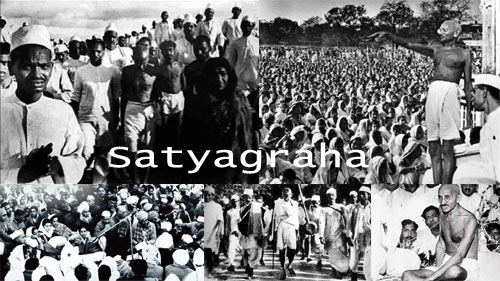Satyagraha: The Art of Defying Oppression without Becoming Oppressors
by Devi Prasad

Gandhian civil resistance poster; courtesy peacetopia.com
To begin with I shall discuss some of the commonly used terms in connection with nonviolent action against oppression, and which are often mistakenly understood to be the same as the Satyagraha practiced and advocated by Gandhi. This is to try to point out the differences between the concepts these terms represent and how they are not quite the same as the concept of Satyagraha. These terms are passive resistance, non-cooperation, direct action, civil disobedience and non-resistance. My aim is not to minimise, even to the slightest degree, the merits, uses and strength of these methods, but to point out that in contrast to any of them Satyagraha is a complete philosophy, as well as the technique of fundamental social change. Whereas the philosophy of Satyagraha implies a holistic approach to both long term as well as immediate issues facing humankind, the practice of the above-mentioned concepts is, by definition, limited to particular situations without being necessarily related to other social or political problems.
Passive Resistance
Gandhi often used “passive resistance” to denote what he meant by Satyagraha. Nevertheless, he has been careful enough to make a clear distinction between the two concepts. As he wrote in 1924, “Passive resistance is the weapon of the weak … The result of our using the phrase ‘passive resistance’ in South Africa was not that people admired us by ascribing to us the bravery and the self-sacrifice of the Suffragists, but we were mistaken to be a danger to person and property, which the Suffragists were, and even a generous friend like Mr Hosken imagined us to be weak. The power of suggestion is such that a man at last becomes what he believes himself to be. If we continue to believe ourselves and let others believe, that we are weak and helpless and therefore offer passive resistance, our resistance would never make us strong, and at the earliest opportunity we would give up passive resistance as a weapon of the weak … While in passive resistance there is a scope for the use of arms when the suitable occasion arises, in Satyagraha physical force is forbidden even in the so-called most favourable circumstances. Passive resistance is often looked upon as a preparation for the use of force while Satyagraha can never be utilised as such.”
Read the pdf of the complete article here: Satyagraha
Reference: IISG/Devi Prasad Archive, Box 57. We are grateful to IISG for their assistance and permission.
A NOTE ON THE TEXT: The pdf presented here is a scan of the original document as located at the International Institute of Social History in Amsterdam. Unfortunately, page 12 of the document could not be located within the archive, nor the endnotes referenced in the original. Nonetheless we considered the document important enough to be published here.
EDITOR’S NOTE: Devi Prasad (1921-2011) was a studio potter, peace activist, artist, and in the 1960s and 70s acting director of War Resisters’ International (WRI). As a child he was educated at Rabindranath Tagore’s school at Shantiniketam, and in 1944 Gandhi invited him to his ashram at Sevagram to teach pottery. Besides spinning cotton and weaving cloth (khadi), the most famous of Gandhi’s methods of self-sufficiency, Gandhi also valued and encouraged all the crafts, and insisted they be included in the curriculum of his ashram schools. Our thanks to the International Institute of Social History (IISG) for their cooperation and permission. Please note: We have also posted Prasad’s article on Gramdan.




